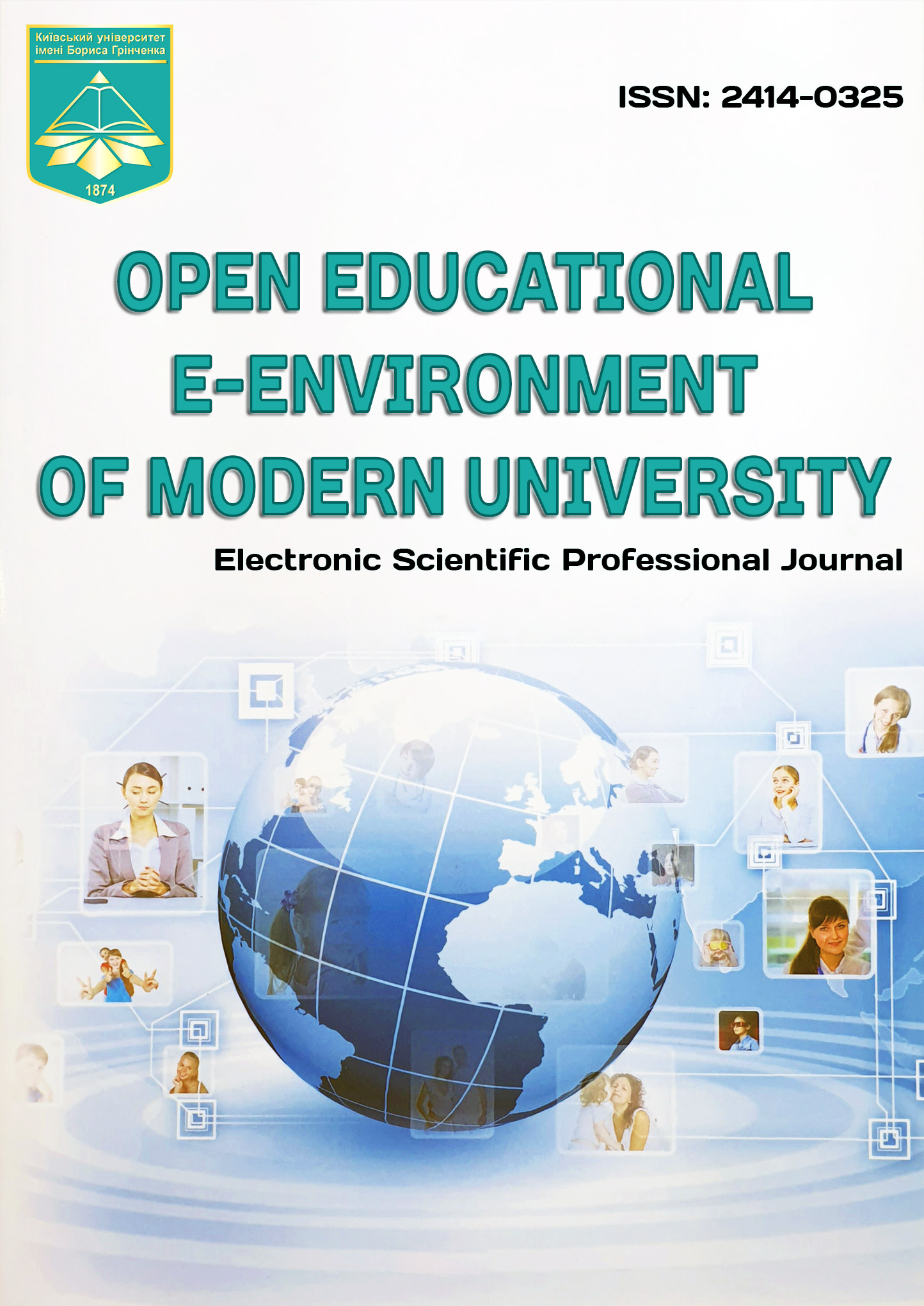PRINCIPLES OF MILITARY MEDICAL TRAINING IN THE CONTEXT OF DIGITAL TRANSFORMATION IN HEALTHCARE
DOI:
https://doi.org/10.28925/2414-0325.2023.153Keywords:
military medical training; principle of innovation; principle of orientation to network services; principle of reliance on digital tools; digital transformation, military medicineAbstract
The work is devoted to the problem of military medical training in the context of digital transformation in healthcare. The aim of this work is to justify and highlight the directions for implementing specific principles of military medical training in the context of digital transformation in healthcare. The expediency of specific principles in military medical training (the principle of innovation, the principle of orientation to network services, and the principle of reliance on digital tools) is substantiated; the content and essence of specific principles have been clarified; directions for the implementation of specific principles in the process of military medical training are determined. It is shown that the need for an innovative focus in military medical training is driven by several factors, including organizational innovations that contribute to the effective transformation of the healthcare system, digital innovations aimed at automating processes related to medical data, innovative medical technologies, and pharmaceutical and medical-technical innovations associated with the use of advanced methods for diagnosis, treatment, and patient care. It is established that the principle of orientation towards network services allows for effectively combining formal, informal, and informal education for military doctors, fostering lifelong self-education skills. We specify that the principle of orientation towards network services involves familiarizing military doctors with the results of fundamental research in the medical field and relies on the open access to full-text digital publications, both domestic and international. The principle of reliance on digital tools recognizes the potential of digital tools and the appropriateness of their use in the process of military medical training.
Downloads
References
Savitsky, V., Kuts, T. & Sidorova, N. (2022). Evaluation of the Organization and Quality of Distance Learning for Physicians in Crisis Situations: Rationale and Design of the DILEMMA Study. Contemporary Aspects of Military Medicine. doi: 10.32751/2310-4910-2022-29-3
Katerynchuk, O. (2018). Features of Teaching Military Special Training to Family Physicians.
https://www.pdmu.edu.ua/storage/n_
process_nmv/files/xfzfXBPN3STVivk9SAtFUE6OXydhuroSzTY5LuYS.pdf (in Ukrainian)
Tarasenko, V., Kuchmistova, O., Solomennyy, A. & Pidlisny, O. (2019). Structuring the Specifics and Consequences of Combat Trauma in Servicemen. Military Medicine of Ukraine. № 19. doi: 10.32751/2663-0761-2019-04-16
Training of military doctors: problems and prospects (2023). https://armyinform.com.ua/2021/07/01/pidgotovka-vijskovyh-likariv-problemy-i-perspektyvy/ (in Ukrainian)
Explanatory dictionary of basic pedagogical terms (2023). https://uk.wikipedia.org/wiki/ (in Ukrainian)
Mochalov, Yu. (2014). Innovative activity in the work of health care institutions. Practice of managing a medical institution. №3. https://dspace.uzhnu.edu.ua/jspui/bitstream/lib/23597/1/Pages%20from%20Mediki_3_2014_inet.pdf. (in Ukrainian)
Andriievska, V. (2019). Theoretical and methodological principles of training future primary school teachers for the use of information and communication technologies in professional activity. http://hnpu.edu.ua/sites/default/files/files/2019/02/diser_Andriievska1.pdf. (in Ukrainian)
Roehrs, A, da Costa & C.A., da Rosa, R.R. (2017). OmniPHR: a distributed architecture model to integrate personal health records. Journal of Biomedical Informatics. Vol.71. DOI: 10.1016/j.jbi.2017.05.012
Yemets, O. (2023). Digitization of medicine: how the state and business jointly build the market of digital services.
https://dev.ua/blogs/posts/iemets-1688986704. (in Ukrainian)
Innovative technologies in medicine. (2023). https://www.bsmu.edu.ua/blog/1033-innovatsiyni-tehnologii-u-meditsini/ (in Ukrainian)
Beinke J., Fitte C. & Teuteberg F. (2019). Towards a Stakeholder-Oriented Blockchain-Based Architecture for Electronic Health Records: Design Science Research Study. Journal of Medical Internet Research, 21(10). DOI: 10.2196/13585
Sharma, Y. & Balamurugan, B. (2020). Рreserving the Privacy of Electronic Health Records using Blockchain. Procedia Computer Science. Vol. 173. DOI: 10.1016/j.procs.2020.06.021
The Stanford Virtual Heart – Revolutionizing Education on Congenital Heart Defects (2023).
https://www.stanfordchildrens.org/en/innovation/virtual-reality/stanford-virtual-heart
Mindmaze (2023). https://mindmaze.com/digital-therapies-for-brain-repair/
Diabetes – Medical VR Game (2023) https://sbanimation.com/case-studies/diabetes-voyager-medical-vr/
Kahl, M., Gertig, M., Hoyer, P., Friedrich, O. & Gilbert D.F. (2019). Ultra-Low-Cost 3D Bioprinting: Modification and Application of an Off-the-Shelf Desktop 3D-Printer for Biofabrication. FrontBioeng Biotechnol. DOI: 10.3389/ fbioe.2019.00184.
Introduction to Medical 3D Printing and 3D Printers for Healthcare (2023). https://formlabs.com/asia/blog/3d-printing-in-medicine-healthcare/
Vitor La Banca, Ana Victoria Palagi Vigano, Luiz Giglio, Guilherme Henrique Vieira Lima, Henrique de Lazari Schaffhausser, Luiz Fernando Michaelis & Roberto Yukio Ikemoto (2023). Gender differences in Glenoid and Coracoid Dimensions evaluated through 3D Printed bone models in the context of Anterior Shoulder Instability Surgery – An exploratory study. Annals of 3D Printed Medicine. DOI: 10.1016/j.stlm.2023.100122
Rudynskyi, O.V., Kozak, N.D. & Chusta S.M. (2019). Distance learning: features and application algorithm during continuous professional development of military doctors. Military medicine of Ukraine. DOI: 10.32751/2663-0761-2019-04-05
Bilousova, L. I. & Kiselyova, O. B. (2012). Competence of self-education in modern conditions. Information technologies and teaching aids, №1 (27).
Overview of mechanical ventilation (2023). https://www.msdmanuals.com/uk/professional/critical-care-medicine/respiratory-failure-and-mechanical-ventilation/overview-of-mechanical-ventilation. (in Ukrainian)
Tsimbalyuk, V. I., Antipkin, Yu. G. & Bazika, D. A., et al. (2019). Status and prospects of fundamental research development in scientific institutions of the National Academy of Medical Sciences of Ukraine. https://amnu.gov.ua/ctan-ta-perspektyvy-rozvytku-fundamentalnyh-doslidzhen-u-naukovyh-ustanovah-naczionalnoyi-akademiyi-medychnyh-nauk-ukrayiny/ (in Ukrainian)
Fomin, O. O., Fomina, N. S., Kovalchuk, V. P. & Aslanyan, S. A. (2023). Microflora of a modern combat wound and its sensitivity to antibiotics. Part I. Ukrainian Medical Journal. doi: 10.32471/umj.1680-3051.155.244023
Friedrichson, N. V. IT technologies in medicine (2023). https://naukam.triada.in.ua/index.php/konferentsiji/42-dvanadtsyata-vseukrajinska-praktichno-piznavalna-internet-konferentsiya/462-it-tekhnologiji-v-meditsini. (in Ukrainian)
Published
How to Cite
Issue
Section
License
Copyright (c) 2023 Halkina T., Andriievska V.

This work is licensed under a Creative Commons Attribution-NonCommercial-ShareAlike 4.0 International License.













1.jpg)








